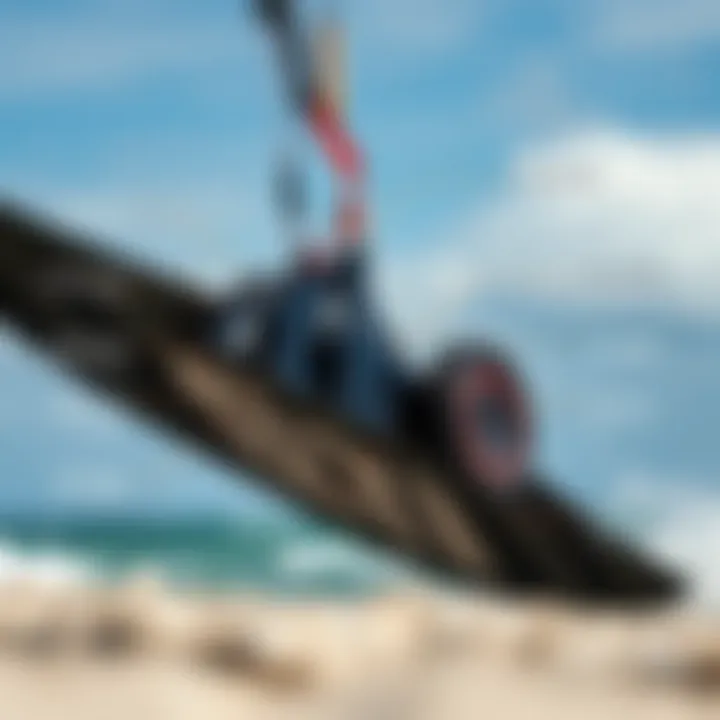Understanding the Turbo Sling: Key Insights for Kiteboarders


Intro
Kiteboarding is a sport where performance hinges on various factors, and one particularly crucial element is the turbo sling. This component plays a pivotal role in how kites handle under different conditions, influencing both maneuverability and speed. The turbo sling is designed to engage with the power of the wind, providing riders with a unique experience that is both exhilarating and demanding. Whether you are new to the sport or a seasoned rider, understanding the intricacies of the turbo sling can greatly enhance your kiteboarding journey.
To make the most of this detailed exploration, we will dive into the essential aspects of gear selection, the significance of skill development, and practical tips for maximizing your experience on the water. Our aim is to provide a comprehensive analysis that not only highlights the technical features but also addresses real-world applications and safety considerations.
Gear Selection
Selecting the right gear is not just about having the latest toys on the market; it's about finding the right fit that complements your style and level.
Types of Kites
In kiteboarding, kites come in various shapes and sizes, each tailored for specific conditions and riding styles. Here are some popular types:
- C-Kites: Known for their high performance, these kites excel in freestyle and advanced tricks. They offer great power and strong pull but can be tricky to handle for beginners.
- Bow Kites: These kites give more power and lift, making them ideal for beginners. They provide excellent depower capabilities and are forgiving in gusty winds.
- Delta Kites: They combine the features of C-kites and Bow kites, delivering impressive performance while being suitable for a wider range of riders.
When choosing a kite, consider factors such as wind conditions, your skill level, and the type of riding you plan to do. Tailoring your kite selection to these elements can mean the difference between flight and frustration.
Choosing the Right Board
A good kite needs a good board. Kiteboards vary widely, impacting speed and handling in many ways. For newbies, here are the key options:
- Twin-Tip Boards: These are versatile and allow for riding in both directions. Great for beginners and easy to maneuver.
- Directional Boards: Ideal for surf-style riding, they can be tricky to master but provide an entirely different experience on waves.
- Foil Boards: Best for flat water and light wind conditions, these boards offer a unique ride that can elevate the kiteboarding experience.
It's essential to match your board with your kite's characteristics to achieve a balanced setup. Think of it like a dance; both kite and board need to move in harmony.
Skill Development
Successful kiteboarding isn't just about the gear; it's also about developing the right skills.
Essential Techniques
Mastering basic techniques can significantly elevate your overall experience:
- Water Start: Learning to get up on the board quickly is crucial. This technique can make or break your session.
- Carving: Once you are up and moving, learning to carve will allow you to control your speed and direction more effectively.
- Jumping: A key highlight of kiteboarding. Understanding how to harness wind power for jumps takes practice but adds thrill to your ride.
Progression Tips
As you gain confidence, consider pushing your boundaries:
- Practice Regularly: The more you practice, the more instinctive your movements will become.
- Seek Feedback: Learning from a more experienced rider or instructor can save you time by helping you avoid common mistakes.
- Stay Educated: Keep up with new techniques and gear innovations through forums like reddit.com or dedicated kiteboarding communities on platforms like Facebook.
Ultimately, the path to becoming a proficient kiteboarder intertwines both gear selection and skill mastery. Dive into these elements with passion and commitment, and you will find yourself soaring above the water, not just dabbling.
"Knowledge of the equipment is just as important as experience in the water. Both go hand in hand to achieve a greater ride."
Whether you're striving for that perfect jump or just want to enjoy a day on the water, mastering the turbo sling along with the gear will surely enhance your kiteboarding adventures.
For those keen on expanding their knowledge further, resources like en.wikipedia.org/wiki/Kiteboarding, britannica.com, and various instructional videos on YouTube can provide additional insights.
Understanding the Turbo Sling
The turbo sling stands as a hallmark of innovation in the world of kiteboarding. In this article, we embark on a detailed exploration of how this crucial component enhances the overall experience during kiteboarding. Understanding the turbo sling goes beyond merely knowing what it is; it involves recognizing its profound impact on performance, control, and safety. Kiteboarding is not just a sport; for many, it's a passion, a lifestyle, and for some, it may even lead to professional endeavors. Therefore, grasping the significance of the turbo sling is essential for all participants in this thrilling activity.
The turbo sling effectively plays a pivotal role in kite dynamics. Its design and functionality intersect beautifully with the kite, providing a unique advantage that can be seen in various conditions, from gentle breezes to robust winds. Kiteboarders who understand this component can make informed choices that directly enhance their skills and capabilities on the water. This understanding not only benefits the individual rider but contributes to a more enjoyable collective experience as well.
Defining the Turbo Sling
At its core, the turbo sling is a specialized design feature embedded within kites that aims to optimize performance during rides. Think of it as the unsung hero of the setup that acts somewhat like a bridge between the user’s input and the kite's response in the air. It primarily assists in managing the tension and lift offered by the kite, permitting a more stable and controlled experience. In simpler terms, it regulates how much power is transferred from the kite to the rider, which is critical in various conditions. The precise mechanics behind the turbo sling might seem overwhelmingly complex, but its result is tangible and appreciated by seasoned kiteboarders alike.
Key Features of the Turbo Sling
The unique attributes of the turbo sling can be attributed to a few key features that make it indispensable for kite enthusiasts:
- Increased Responsiveness: The turbo sling enhances the kite’s responsiveness, allowing for quick adjustments during complicated maneuvers. This feature remains paramount when trying to catch air or navigate choppy waters.
- Lift Management: An essential part of kiteboarding is lift. The turbo sling aids in managing this lift, ensuring that riders don’t feel overwhelmed by gusts of wind while also benefiting from optimal elevation during jumps.
- Durability: Hong also embraces design materials that withstand the rigors of the elements. A well-constructed turbo sling can last various seasons of extreme play.
These features cater to a spectrum of riders, from newcomers honing their skills to professional kiteboarders pushing the limits of the sport.
Evolution of the Turbo Sling Design
The journey of the turbo sling from its inception to the present showcases significant advancements in kiteboarding technology. Originally, many early models lacked the sophisticated mechanics we see today; they were cumbersome and limited in their performance. As kiteboarding gained traction, designers began investigating materials and shapes that could enhance performance. This iterative process took cues from aerodynamic principles, paving the way for the incorporation of lighter materials and ergonomic designs.
In recent years, the innovations have accelerated. Contemporary models now integrate lightweight synthetic fibers which facilitate faster speeds without compromising strength. Moreover, the shapes have evolved; they are refined to yield improved aerodynamic efficiency, making the turbo sling more accessible and functional for all types of riders.
"Understanding the evolution of the turbo sling not only informs current practices but sparks curiosity about what the future holds for kiteboarding technology."
In summary, grasping the intricacies of the turbo sling provides deep insight into its function within the kiteboarding world. It embodies not just a tool but a bastion of the sport's continual growth and evolution, fundamental for anyone stepping into this exhilarating pastime.
Technical Insights
The realm of kiteboarding thrives on precision, and Technical Insights regarding the Turbo Sling delve into what makes this component essential for achieving top-notch performance on the water. Understanding the material composition, mechanical functionality, and performance metrics of the Turbo Sling is crucial for kiteboarders aiming to elevate their game. By grasping these technical elements, enthusiasts can make informed decisions about equipment and adapt to varying conditions. This section sheds light on the intricacies involved in the Turbo Sling's construction and operational effectiveness, ensuring that both newcomers and veterans are well-equipped to harness its capabilities.
Material Composition
The backbone of any gear, including the Turbo Sling, is its material composition. A careful selection of materials is what gives the sling its strength, durability, and overall functionality. Many manufacturers have shifted towards using high-tenacity polyester or nylon blends for their flexibility and resistance to wear. Such materials are relatively lightweight yet highly durable, bringing an optimal balance between performance and longevity.
Key aspects to consider include:
- Tensile Strength: This is crucial as it determines how much force the sling can withstand before failing.
- UV Resistance: Given that kiteboarding often occurs in sunny conditions, materials are treated to resist degradation from UV rays.
- Weight: Lightweight slings contribute to better maneuverability and handling.
- Coating: Some slings come with additional coatings that provide water repellency, making them less prone to absorbing moisture.
Through such careful crafting of materials, the Turbo Sling ensures a product that suits a variety of kiteboarding needs.


Mechanical Functionality
Understanding the mechanical functionality of the Turbo Sling reveals how it interacts with the overall kiteboarding system. At its core, the Turbo Sling operates as a pivotal connection between the kite and the rider. Its design allows for a direct transfer of forces, translating a rider’s maneuvers into immediate responses.
Its mechanics enable a smoother transition during turns and jumps, improving overall control.
- Direct Load Distribution: This feature ensures that the force is evenly distributed across the sling, preventing weak points that could lead to failure.
- Dynamic Response: The sling’s ability to respond dynamically to rider inputs plays a massive role when executing tricks or maneuvers.
- Flexibility vs. Rigidity: The ideal configuration maintains an optimal balance of firmness without being overly stiff, allowing the kite to react in a responsive manner.
When all these elements combine effectively, kiteboarders can enjoy both enhanced safety and performance.
Performance Metrics
Performance metrics provide a tangible way to gauge how well the Turbo Sling functions. Metrics often include parameters such as tension, stretch under load, and lifespan. These measurements offer kiteboarders a framework for evaluating different products at their disposal.
Important performance metrics include:
- Strength-to-Weight Ratio: This is vital for performance, as it allows for better handling without sacrificing strength.
- Durability Rating: How long the sling lasts under regular usage conditions can influence purchasing decisions.
- Speed of Deployment: An effective sling should allow for quick setup and adjustments on the fly.
- Adaptability in Varying Conditions: Testing how the sling performs in changing weather situations can highlight its versatility.
Understanding these metrics not only aids in selecting the right gear but also empowers riders to gauge their own performance against established standards.
"A well-chosen Turbo Sling can uplift an entire kiteboarding experience, translating expectations into triumphs on the water."
Gaining insight into the materials, mechanical functionality, and performance metrics of the Turbo Sling arms kiteboarders with the knowledge necessary for optimizing their experience, ensuring that every ride is built on a foundation of sound technical understanding.
Benefits of Implementing the Turbo Sling
The adoption of the Turbo Sling in kiteboarding brings several advantages that can significantly enhance the overall experience for users. This section digs into how enhanced control, increased speed, and improved glide efficiency are all intertwined to create a better gliding and maneuvering experience in the ever-changing wind conditions.
Enhanced Control
One of the standout features of the Turbo Sling is its ability to provide enhanced control to kiteboarders. This control stems from the sling's design, which optimizes the angle of attack and leads to more immediate responsiveness. Adjusting the tension in the slings directly influences the kite's behavior during a ride. For instance, when the wind picks up unexpectedly, a kite equipped with a Turbo Sling can be controlled with more precision, allowing the rider to maintain stability and perform swift turns without losing balance.
Kiteboarders often find that other slings do not offer the same level of fine-tuning capability. This becomes particularly important during intense sessions or competitive events. Riders who favor speed over excessive power appreciate the capacity to keep their kite flying steadily while pushing the limits.
Besides these practical considerations, having enhanced control naturally builds confidence, allowing riders to experiment with new tricks or challenging conditions. Therefore, integrating the Turbo Sling into one's gear can fundamentally change how a rider approaches both casual outings and competitive events.
Increased Speed
Speed is the name of the game in kiteboarding, and the Turbo Sling can make a sizeable contribution to achieving quicker runs. Due to its design that reduces drag and improves airflow, riders often enjoy noticeably higher speeds. A well-tuned Turbo Sling allows the kite to create lift more efficiently, meaning riders can harness wind energy like never before.
Moreover, many riders report that while using the Turbo Sling, the acceleration becomes more potent. This is not just about raw speed; it includes how quickly a kite can translate wind into forward momentum. Such factors are pivotal during races or high-stakes kiteboarding events where every second counts.
In practical terms, this means that recreational riders can also enjoy faster runs down the beach or through the water. When you ride with the Turbo Sling, it feels as though you can ride the wind, even in less-than-ideal conditions. This not only adds to the enjoyment but also increases the reach and versatility of what can be done on the water.
Improved Glide Efficiency
Achieving efficiency in glide is crucial for extending rides and reducing fatigue. With the Turbo Sling, the kite typically finds a better lift-to-drag ratio, meaning those hard-fought gains don't evaporate into the air. This efficiency ensures that a kite can maintain height and speed longer, leading to fewer interruptions or the need for constant adjustments during a run.
"With the Turbo Sling, it feels like you're almost flying instead of just riding on the water."
— Experienced Rider
When a kiteboarder can glide through the wind with minimal effort, the long sessions on the water become a lot more enjoyable. Additionally, riders are better positioned to make those sharp turns and jumps, thanks to the way the Turbo Sling maintains a good airflow around the kite.
To sum up, integrating the Turbo Sling into kiteboarding routines paves the way for various advantages, from enhancing control and speed to improving the overall glide efficiency. An informed choice leads to not only better performance but substantially enhances the experience on the water, creating a world of possibilities for kiteboarders at all skill levels.
Practical Applications
The Turbo Sling is more than just a gadget; it’s a game-changer in the kiteboarding scene. For enthusiasts, instructors, and event organizers, understanding the practical applications of this piece of equipment is crucial. It’s about maximizing efficiency and enjoyment, and knowing how to use the Turbo Sling effectively can take a kiteboarding experience from ordinary to extraordinary.
Choosing the Right Conditions
Just like a chef selects the finest ingredients for a recipe, a kiteboarder must choose the right conditions to fully utilize the Turbo Sling. Wind strength and direction are paramount factors. Ideally, you want steady winds between 15 to 25 knots for the best performance. Too little wind and you may find yourself struggling to maintain lift; too much wind could turn a thrilling ride into a perilous one.
- Local Weather Patterns: Understanding local weather conditions is vital. It’s beneficial to familiarize yourself with seasonal winds at your favorite spot – some locations have winds that are more favorable for kiteboarding during certain times of the year.
- Water Conditions: Smooth waters can make or break your outing. It’s best to thrive in flatter waters rather than choppy surfaces, which can disrupt your glide and stability.
As you prepare for your session, keep an eye on weather forecasts. Websites such as Windy can make this easier, providing real-time data on wind strengths.
Integrating with Different Kites
Not every kite is built the same. Integrating your Turbo Sling with the right kind of kite can be a pivotal factor in achieving optimal performance. Compatibility between your kite and the Turbo Sling can affect lift, responsiveness, and safety.
- All-around Kites: These are versatile enough to work well with the Turbo Sling, making them an ideal choice for beginners or those who enjoy varying conditions.
- Freestyle and Wave Kites: If honing your extreme skills, pairing specific freestyle or wave kites with the Turbo Sling can offer increased control and quicker responsiveness.
Each kite type has its dynamics. Familiarize yourself with how your specific kite interacts with the Turbo Sling. Mastering this relationship is essential for a smoother ride and greater performance.
Techniques for Optimal Usage
Like any tool, knowing the ins and outs of the Turbo Sling can lead to a more effective experience. Here are some techniques to enhance your outing:
- Proper Launch Techniques: Ensure that you’re not launching in excessive winds. A strong gust can send your kite taking off uncontrollably. Use smooth and deliberate movements to maintain control.
- Angle of Attack: Adjusting the angle of your kite can drastically change how the Turbo Sling performs during your ride. Keeping a higher angle can improve lift, whereas a lower angle might help in quick descents.
- Body Movement: Your body positioning plays a substantial role in optimizing the usage of the Turbo Sling. Leaning slightly back during flight can increase speed, while shifting your weight forward can help in achieving better control during turns.
Taking the time to practice these techniques can ensure a safer and more enjoyable experience on the water.
"Understanding how to utilize your gear is half the battle in kiteboarding. The Turbo Sling is a fantastic tool if you know how to get the most from it." – Experienced Kiteboarder
In summary, making informed decisions about conditions, proper integration with kites, and mastering usage techniques allows kiteboarders to harness the full potential of the Turbo Sling, enhancing their overall experience on the water.
Safety Considerations
In the exhilarating world of kiteboarding, the thrill of a perfect ride can be overshadowed by risks associated with equipment, conditions, and personal limitations. Safety considerations are vital for anyone looking to explore the fun and freedom of the turbo sling. Understanding the potential dangers not only helps in making informed decisions but also promotes a culture of responsibility among kiteboarders. Well, let’s break down the essentials of safety when it comes to utilizing this innovative gear.
Common Risks


Navigating the water or the air with a turbo sling brings its share of common risks that every kiteboarder should be aware of:
- Equipment Failure: From frayed lines to worn-out harnesses, equipment malfunction can lead to serious accidents. Inspecting your gear regularly is crucial—not just a once-a-season thing, but after every session.
- Environmental Hazards: Current changes, weather shifts, and hidden obstacles can put riders in precarious situations. Always check weather forecasts and know the water conditions before hitting the waves.
- Personal Injury: Misjudging maneuvers or overestimating one’s abilities can lead to crashes. It's essential to stay within your limits, especially when trying new techniques or stunts.
- Collisions: Riding in crowded areas can increase the chance of colliding with other kiteboarders or swimmers. Always be aware of your surroundings—having a good peripheral vision is key.
"Safety is not just a priority; it’s a way of life on the water." Being proactive can make all the difference.
Preventative Measures
To mitigate risks and enjoy a more seamless experience on the water, kiteboarders should adopt several preventative measures:
- Regular Gear Checks: Before every outing, run through a checklist of your equipment. Look for any signs of wear and tear, and replace anything that seems off. Important to note, not all frays are easily visible. A close inspection can save you from potential disasters.
- Know Your Limits: Everyone has a different comfort zone. Push yourself, but don’t get reckless. If conditions are too rough, or if you’re feeling fatigued, it’s better to sit it out. Your body needs to be in top condition to react appropriately.
- Educate Yourself: Attend workshops or training sessions focusing on safety and techniques, as they can provide valuable insights. Many local boardsports schools offer excellent programs. You can always check forums on Reddit or Facebook for nearby recommendations.
- Signal Awareness: Use clear hand signals with fellow riders to communicate your intentions. Establish a system for common misunderstandings helps in crowded waters where verbal communication is difficult.
- Emergency Preparedness: Always carry a personal flotation device, a first aid kit, and a way to signal for help. You might find yourself in a challenging situation where having the right tools can be a lifesaver.
By keeping these considerations and preventative measures at the forefront of your kiteboarding practice, you’ll not only enhance your personal safety but also inspire those around you to adopt the same conscientious mindset. Remember, kiteboarding is about enjoying the moment, and ensuring safety allows us to savor every single ride.
Innovations in Turbo Sling Technology
In the fast-paced world of kiteboarding, the continual evolution of equipment plays a crucial role in enhancing performance and safety. Innovations in turbo sling technology are carving out new paths for both budding enthusiasts and seasoned veterans. Understanding these advancements is essential because they directly impact everything from control to efficiency on the water. As kiteboarding technology advances, staying updated on the latest innovations not only elevates your personal performance but also shapes the future of the sport itself.
Current Innovations
The advancements in the turbo sling realm are nothing short of impressive, showcasing the dedication of manufacturers to push boundaries. Here are some key innovations shaping the current landscape:
- Material Advancements: The integration of lighter yet more durable materials such as high-tenacity nylon has transformed the physical properties of slings, allowing for better strength-to-weight ratios. This means that kiteboarders can achieve enhanced responsiveness without sacrificing durability.
- Smart Technology: The emergence of digital monitoring systems is gaining traction. These smart systems provide real-time data on tension, load distribution, and even environmental conditions. One standout example is the use of IoT sensors that deliver live feedback to the rider via a connected app. Such features can help optimize performance and safety, ensuring that riders remain informed.
- Design Modifications: Recent design innovations focus on aerodynamics and easy handling. New shapes and configurations minimize drag, resulting in improved lift and overall efficiency. A perfect instance is the use of asymmetric designs that cater to dynamic riding conditions, giving users greater control.
These innovations not only enhance the riding experience but also aim to reduce the risk of accidents, ensuring that safety remains paramount as performance enhances.
Future Trends
Looking into the crystal ball of turbo sling technology, we can identify several trends that are likely to shape the future of kiteboarding equipment. Here are a few developments to keep an eye on:
- Sustainability: As global concerns about the environment rise, manufacturers are diving into sustainable production techniques. Innovations could include the use of recyclable materials in the construction of slings. This shift not only resonates with eco-conscious riders but also potentially reduces long-term costs for manufacturers through the use of green technologies.
- Customization: The forthcoming wave of turbo slings may involve bespoke designs tailored to individual rider preferences and conditions. Think of modular systems that allow riders to mix and match components based on current needs. This level of customization could revolutionize how kiteboarders approach their equipment, making it more personal.
- AI Integration: The future might see more extensive application of artificial intelligence in performance analysis. Imagine an advanced system that learns from your riding patterns and offers agility-enhancing tips, or even optimizes sling settings dynamically while you ride. Although this may sound futuristic, it’s becoming increasingly feasible.
Overall, the innovations within turbo sling technology are paving the way for a new era in kiteboarding. As trends evolve, kiteboarders can anticipate equipment that not only meets their needs but also empowers them to push the limits of their sport. Keeping abreast of these advancements ensures that every rider remains at the top of their game.
Comparing the Turbo Sling with Other Slings
Understanding the distinction between the Turbo Sling and other slings is pivotal for kiteboarders, whether they’re just starting out or have years of experience under their belts. In a sport where every detail can make the difference between a thrilling ride and a disastrous fall, knowing how the Turbo Sling stands up against its competitors is essential. This comparison digs into specific performance metrics, user experience, and the salient benefits inherent to each option.
Performance Parameters
When it comes to performance, not all slings are created equal. The Turbo Sling possesses unique features that enable it to excel in various conditions. Key performance parameters include:
- Lift Efficiency: The Turbo Sling provides enhanced lift, crucial when water conditions are less than ideal. This translates into a better response when trying to jump or glide over waves.
- Drag Reduction: Compared to traditional slings, the Turbo Sling is engineered to minimize drag. It allows for smoother transitions and quicker acceleration, making it a go-to for competitive kiteboarders.
- Stability: The Turbo Sling's design qualities offer unmatched stability in turbulent winds. Users report feeling more secure, enabling them to push their boundaries safely.
In contrast, other slings might prioritize durability or cost-effectiveness, which can sometimes lead to compromises in these performance metrics. For instance, a conventional sling might be less expensive but could lack the precision lift and control found in the Turbo Sling.
User Experience
User experience is subjective, yet integral to the performance of any kiteboarding equipment. The sentiments of kiteboarders about the Turbo Sling reveal a mix of satisfaction and inspiration. Factors contributing to this experience include:
- Ease of Maneuverability: Many riders have noted that the Turbo Sling allows for sharper turns with less effort. This feature means that even on challenging courses, riders can maintain control without feeling overwhelmed.
- Adaptability: Whether you’re on flat water or choppy seas, the Turbo Sling adapts better to changes in conditions compared to its peers. This adaptability leads to increased confidence, encouraging riders to experiment with new maneuvers.
- Feedback Mechanisms: Riders often appreciate immediate feedback with the Turbo Sling. The sensations experienced when flying above the water are more pronounced, letting users react quickly to changes in wind or water condition.
These aspects of user experience are often cited by professional kiteboarders and instructors as pivotal when selecting gear. For example, many instructors emphasize how a slick feedback mechanism can significantly shorten the learning curve for newcomers.
"Choosing the right sling is not about cost but about how it complements your riding style and comfort on the water."
— Experienced Kiteboarding Instructor
Expert Opinions and Testimonials
In any niche sport, understanding the perspectives of seasoned practitioners can illuminate facets that are not easily captured through technical data alone. The opinions and testimonials from experts in the field of kiteboarding serve as guideposts, providing insights into the real-world effectiveness and practical applications of the turbo sling. By tapping into these experiences of professional kiteboarders and instructors, we can glean valuable knowledge that aids both beginners and more experienced riders in optimizing their equipment choices and strategies.
Insights from Professional Kiteboarders
When it comes to the turbo sling, professional kiteboarders often discuss how the design influences maneuverability and speed. Many enthusiasts find that feedback from these athletes showcases how nuanced adjustments can lead to significant performance enhancements. For instance, professional kiteboarder Jake Smith noted in a recent interview, "The turbo sling gave me that extra zip during high winds when I needed to pop up quickly. It’s become a go-to for my competitions."
"Professional insights can provide that edge we all need in mastering the sport. Every detail can count, especially with gear that affects speed and control."
- Lisa Torres, Professional Kiteboarder
The importance of grip, stability, and how the turbo sling interacts with different types of kites are also recurring themes. This feedback is crucial for manufacturers, as enhancements based on these testimonies can lead to updated models that better meet the demands of serious kiteboarders. Moreover, such endorsements often enhance the credibility of a product, helping potential buyers make informed decisions.
Feedback from Instructors
Kiteboarding instructors play a critical role in shaping how novices interact with the sport. Their observations on the usability and functionality of the turbo sling are invaluable. For example, many instructors emphasize the need for safety and control that the turbo sling provides beginners. Mark Johnson, a kiteboarding instructor with over a decade of experience, stated, "Incorporating the turbo sling in my beginner lessons tends to increase confidence levels. It allows students to focus on their technique rather than worrying about equipment failures."
Instructors often highlight areas such as adjustments for different skill levels, adaptability to various wind conditions, and ease of use. This feedback not only informs potential buyers but also shapes how support materials and training programs are developed.
Thus, the combination of insights from professional riders and instructors creates a robust knowledge base that can assist kiteboarders in making the most of the turbo sling. By embracing the community's collective wisdom, riders can enhance their experience and navigate the complexities of equipment choice with confidence.
Acquiring the Turbo Sling
Acquiring the turbo sling represents a crucial step for anyone looking to elevate their kiteboarding game. Much more than just a piece of gear, it serves as a pivotal connector between the rider and the kite, influencing control and performance. Knowledge about where to buy it and its cost implications can significantly enhance decision-making for both new enthusiasts and seasoned professionals.
When considering the turbo sling, it’s vital to understand that it isn’t a one-size-fits-all solution. Each rider's preference, skill level, and the specific conditions under which they will be kiteboarding all play into the selection process. Knowing what to look for and understanding the nuances of different models can make a world of difference in kite control and overall experience.
Where to Buy
There are several avenues for purchasing a turbo sling, each catering to a different type of buyer. Below are some recommended options:
- Local Retailers: Often, local kite shops carry a variety of slings. Consulting experts in these shops allows buyers to physcially examine products, getting a feel for texture and weight which is crucial for an informed decision.
- Online Stores: Websites like Kiteboarding.com and Amazon offer convenience and a wider selection. They often have customer reviews that can guide you on the performance of certain models. However, pay attention to shipping costs and estimated delivery times.
- Specialized Forums and Marketplaces: Platforms like Reddit or Facebook groups related to kiteboarding frequently feature new and used gear for sale. These can be excellent places to find deals, plus you may get firsthand insights from fellow riders.
Choosing the right outlet means balancing factors like price, customer service, and product variety. One might find that a lower price online could result in a lack of support or expert advice. Consequently, visiting a local shop can sometimes be worth the extra cost.
Cost Considerations


When tackling the topic of cost, it's essential to evaluate both direct and indirect expenses.
- Base Price: Turbo slings can range in price significantly based on materials and innovation. Generally, expect to invest between $100 to $300, but keep an eye on sales during offseasons or local kiteboarding events where discounts may be available.
- Compatibility with Existing Gear: Ensure that the sling matches your kite and board. If you have to replace existing gear to accommodate the new sling, your costs may rise unexpectedly.
- Long-term Investment: While initial costs can be high, consider the durability and performance upgrades that the turbo sling provides. Some may require less maintenance and last longer than alternatives, offering a better return on investment in the long run.
- Warranties and Services: Some brands offer warranties which can protect your investment against manufacturing defects. This can be an important factor when weighing costs, giving peace of mind with a larger upfront financial commitment.
End
Acquiring a turbo sling demands thoughtful consideration of both purchasing routes and financial implications. Understanding the market landscape allows kiteboarders to invest wisely rather than hastily, ensuring that each purchasing decision aligns with personal performance goals. With the right turbo sling in hand, riders can experience the full potential of their kiteboarding adventures.
Maintenance and Care
Regular maintenance and care are essential for ensuring optimal performance and longevity of the turbo sling. Just like you wouldn’t neglect your favorite pair of boarding shoes, the same applies here; a well-cared-for sling can significantly enhance your overall kiteboarding experience. Proper maintenance helps to avoid unwanted surprises during those thrilling rides. It affects everything from the sling's responsiveness to safety while riding, making it a crucial element that kiteboarders cannot overlook.
Routine Maintenance Tips
Keeping your turbo sling in its prime doesn't have to be a daunting task. Here are several practical tips to maintain it:
- After Each Use: Rinse off the sling with fresh water to remove salt, sand, and debris. Salt and dirt might not seem like much, but they can gradually compromise the materials.
- Inspect for Wear: Regularly check for signs of fraying or any damaged stitching. Catching potential issues early can save you from a more significant repair later on.
- Storage: Store your sling in a cool, dry place. Avoid exposing it to direct sunlight for extended periods. UV rays are notorious for breaking down synthetic materials over time.
- Cleanliness: Use mild soap for deeper cleaning but ensure it's well-rinsed afterward. You don’t want any soap residue causing issues during your next ride.
- Adjustments: Small adjustments to the knots as they tend to loosen up can make a big difference. Keeping those knots snug ensures the sling performs as intended.
Tip: Keeping a maintenance log can help you track any repairs or inspections you've completed.
Repairing Minor Damages
No matter how cautious you are, minor damages can occur. Whether it's a loose stitch or a small tear, addressing these promptly can prevent further deterioration. Here’s how to manage minor repairs:
- Sewing Up Small Tears: Use a heavy-duty needle and a nylon thread to sew up small tears. This quick fix can keep the sling operational and prevent the tear from worsening.
- Knot Tying for Frays: If you see frays at the edge, tie a small knot to secure the fibers. This method reduces the chances of further unraveling while giving you more time for a proper fix.
- Fabric Patches: For larger areas, consider fabric patches. Specialized adhesive can secure the patch in place, adding extra durability to the damaged area.
- Seek Professional Help if Needed: If the damage is more substantial than what you can handle, don't hesitate to contact a professional repair service. Getting expert help can save you both time and money in the long run.
"In kiteboarding, just like in life, a little prevention goes a long way."
Ultimately, taking the time for regular maintenance and addressing minor damages as soon as they arise allows you to enjoy your turbo sling to the fullest. These steps not only enhance the sling's lifespan but also contribute directly to your overall performance while kiteboarding. By paying attention to these details, you're setting yourself up for success on the water.
Community Resources
In the realm of kiteboarding, the value of community resources cannot be overstated. It’s in these shared spaces—forums, discussion groups, and training events—that knowledge is cultivated, experiences are exchanged, and camaraderie is built. This section aims to shed light on how these resources can act as navigational beacons for both neophytes and veterans in the kiteboarding scene.
A well-informed community often means safer practices, better skills, and a deeper appreciation for the sport. Engaging with fellow enthusiasts allows individuals to tap into a wealth of information that might not be readily accessible elsewhere. Such exchanges pave the way to enhanced performance and safety, vital components in kiteboarding where the stakes can be notably high.
Forums and Discussion Groups
Engaging in forums and discussion groups can be incredibly enriching. These platforms serve as an online haven where kiteboarders from various backgrounds converge to share insights, tips, and even personal stories. Whether discussing which gear performs best in specific conditions or sharing tales about close calls, these communities provide invaluable peer support.
- Immediate Access to Information: Many seasoned kiteboarders frequent forums, offering advice based on their personal experiences. This means that beginners can learn about common pitfalls and successes without venturing into risky waters themselves.
- Shared Knowledge: Often, problems faced by one kiteboarder are shared by many. Discussing these challenges in a forum setting can lead to collective problem-solving, making the community stronger.
- Networking Opportunities: These spaces can connect individuals for future kiting plans or meet-ups, building lasting friendships.
In essence, the insights gained from forums can be the difference between a satisfying outing and a harrowing experience on the water. While platforms like reddit.com/r/kitesurfing or kiteforum.com are bustling with activity, dedicated regional forums also provide tailored advice relevant to local weather and conditions.
Workshops and Training Sessions
Participating in workshops and training sessions can rocket a kiteboarder’s skills to new heights. They provide structured learning, often led by professionals who understand the nuances of the sport. Here’s why they matter:
- Hands-On Experience: Workshops present the chance to practice skills in a controlled environment, reducing the chance of mishaps that could occur during unfacilitated sessions.
- Expert Guidance: Consulting with instructors or seasoned professionals means you gain insights that self-study often misses. They can pinpoint specific areas for improvement that might not be visible to the untrained eye.
- Community Building: These sessions typically bring together a group of people with similar interests, fostering relationships that extend beyond the water.
To find suitable workshops, consider local kiteboarding schools or organizations. Sites like kiteboarding.com or kiteboardingevents.com often provide listings for upcoming events and training opportunities.
In summary, community resources such as forums and workshops are the backbone of kiteboarding culture. Instead of sailing solo, embracing these platforms can lead to richer experiences on the water, a deeper understanding of gear, and stronger bonds with fellow kiteboarders. By engaging actively in these communal spaces, kiteboarders can truly elevate their skills and enjoyment of the sport.
Environmental Impact
In the ever-evolving world of kiteboarding, the environmental ramifications of equipment choices and practices often take a back seat, but neglecting this aspect can have far-reaching consequences. The turbo sling, while engineered for optimal performance on the water, carries with it the responsibility of awareness, specifically regarding its environmental impact. As kiteboarders, instructors, and event organizers, understanding and addressing these effects helps preserve the beauty of the waterways we so avidly enjoy.
Sustainable Practices
Sustainable practices in kiteboarding are not just a trend; they're a necessity. For the turbo sling, this begins with choosing materials that minimize environmental degradation. Opting for slings made from durable, recyclable materials significantly reduces waste. Here are some practices that can be applied:
- Material Sourcing: Look for manufacturers who employ eco-friendly production methods. Many brands are moving towards using recycled plastics or natural fibers in their products.
- Life Cycle Analysis: Understanding the full life cycle of your gear, from production to disposal, enables kiteboarders to make informed choices. Brands that provide transparency in their sourcing and disposal practices are worthy of support.
- Repair Rather Than Replace: Emphasizing the importance of maintenance can prolong the life of a turbo sling. Repairing minor issues instead of buying new equipment not only saves money but also minimizes waste.
By integrating persistent eco-friendly habits into our routines, we can significantly reduce our carbon footprint and encourage a culture of sustainability within the kiteboarding community. In essence, adopting such practices contributes to the overall preservation of the aquatic environments we cherish.
Recycling and Disposal
When it comes to recycling and disposing of equipment like the turbo sling, the approach is multi-faceted. The average kiteboarder may not consider what happens to their gear at the end of its life, but taking the right steps here is crucial for minimizing environmental harm.
Here are some guidelines to keep in mind:
- Local Recycling Programs: Before tossing old gear, check if local facilities accept kiteboarding materials. Many urban areas have specialized recycling programs that deal with plastics and textiles.
- Manufacturer Take-Back Programs: Some companies might offer take-back schemes where they recycle your old gear. Research brands that implement such programs to ensure your old slings don't end up in a landfill.
- Creative Reuse: Consider alternative uses for broken or outdated gear. Transforming a non-functional turbo sling into a piece of art or using it for DIY projects can keep it out of the waste stream.
Taking the time to think about the end-of-life options for your equipment not only aligns with personal values of sustainability but also nurtures a healthy respect for our shared environment. A kiteboarding experience infused with an awareness of ecological impact ultimately leads to richer interactions with nature—an ethos every kiteboarder should embrace.
"We're not just making waves; we're creating ripples of change."
By actively pursuing sustainable practices and responsible disposal, kiteboarders can play a pivotal role in safeguarding the environments that serve as their playgrounds.
Finale
In wrapping up this comprehensive analysis, it's clear that understanding the Turbo Sling is more than just a technical dive; it's about enriching the overall kiteboarding experience. The crucial takeaway from this article is that a well-informed kiteboarder can make better choices in both equipment and technique, ultimately leading to enhanced performance on the water. By concentrating on the various elements we've discussed, enthusiasts can glean significant benefits that extend beyond technical prowess.
Recap of Key Points
- Defining the Turbo Sling: We've established that the Turbo Sling is not merely a accessory but a pivotal feature in optimizing kite dynamics. The flexibility and responsiveness are what set it apart, enabling users to harness the wind's energy more effectively.
- Key Features: Notable attributes such as lightweight construction and robust material composition were highlighted earlier, which ensure durability without sacrificing performance.
- Safety Considerations: Keeping safety at the forefront helps mitigate risks associated with kiteboarding. Proper usage, understanding risks, and adhering to maintenance regimens are paramount for all riders.
- Innovations and Future Trends: The Turbo Sling continuously evolves, with new technology enhancing its design and performance metrics. As we noted, embracing these advancements can further propel kiteboarding adventures into new realms.
- Practical Applications: Our discussion emphasized the importance of matching the right conditions and techniques for optimal use, as well as integrating the Turbo Sling with various kite systems.
Thus, to wrap it all up, the Turbo Sling serves not only as a functional piece of kiteboarding gear but also as a gateway to maximizing thrill and control on the water. It's about understanding what's at stake and making informed decisions that yield the best possible kiteboarding experiences.
Future of the Turbo Sling
Looking ahead, there’s no doubt that the Turbo Sling will undergo continual improvements. With technological advances shaping every aspect of equipment design, we can expect innovations that enhance both performance and user experience. For instance, the incorporation of smart technologies—like sensors that provide real-time feedback on performance metrics—could transform how kiteboarders interact with their gear.
As amateur and professional kiteboarders alike strive for excellence, future iterations of the Turbo Sling may include:
- Advanced Materials: Lighter and stronger composite materials could be developed, further improving durability while reducing the weight of the sling.
- Customized Design: Heightened personalization options, allowing riders to tailor their slings based on individual riding styles and conditions would be an exciting advancement.
- Increased Safety Features: Innovations focusing on safety—for example, automatic release mechanisms that engage in high-risk scenarios—might become standard features.















